10 Podcasts on Social Media That You Can’t Afford to Miss
- Chandraveer Singh
- Dec 13, 2023
- 17 Mins Read

Undoubtedly, social media remains a highly anticipated platform for marketing, though navigating its complexities has become a new challenge for marketers. Unlike traditional marketing, staying informed about social media updates requires constant vigilance, given the frequent changes on various promotional channels.
The question arises: How can one stay abreast of these updates and effectively incorporate them into a successful promotional strategy? Beyond relying on books, courses, and personal experimentation, turning to social media podcasts can be a valuable resource.
Finding quality social media podcasts can be challenging, but considering the growing trend of podcast consumption—55% of the US population listens to them—many industry leaders and experts share their insights through this medium. Podcasts offer the advantage of flexibility, allowing listeners to absorb information at home, during commutes, workouts, or lunch breaks without the need for a rigid commitment.
Given the multitude of influential voices in the social media landscape, deciding where to start can be daunting. To assist you, here’s a curated list of the seven best social media podcasts of 2024 that you should include in your listening lineup.
Let’s dive in!
1. The Art of Social Media with Tejas Mehta
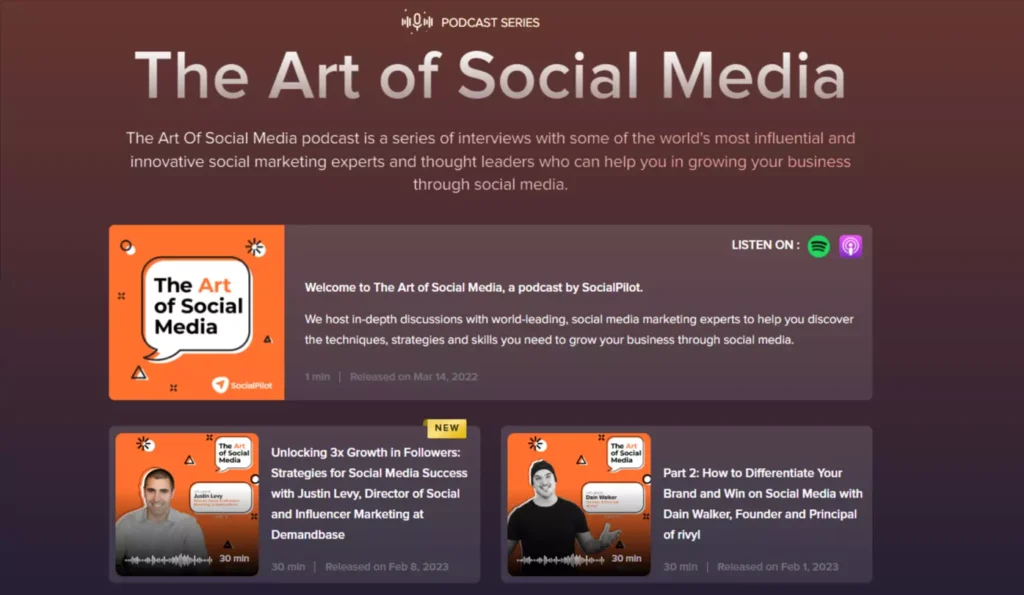
Trend #2: Merging Education With Entertainment
The Art of Social Media” stands out as a popular podcast featuring interviews with prominent social media marketing experts and influencers. The host, Tejas Mehta, boasts over 20 years of marketing experience and co-founded SocialPilot, a well-known social media marketing tool.
With its relatively recent inception, this podcast offers fresh perspectives on a diverse array of marketing topics. By tuning in to its new episodes, listeners can gain valuable insights into current and future marketing trends directly from industry leaders.
The podcast covers a range of hot topics, making it a worthwhile investment of your time. Some noteworthy areas of discussion include influencer marketing, small business development, content strategy, community marketing, agency marketing, and much more. Stay informed and inspired by immersing yourself in the dynamic conversations featured on “The Art of Social Media.
2. Social Pros Podcast with Jay Baer and Adam Brown
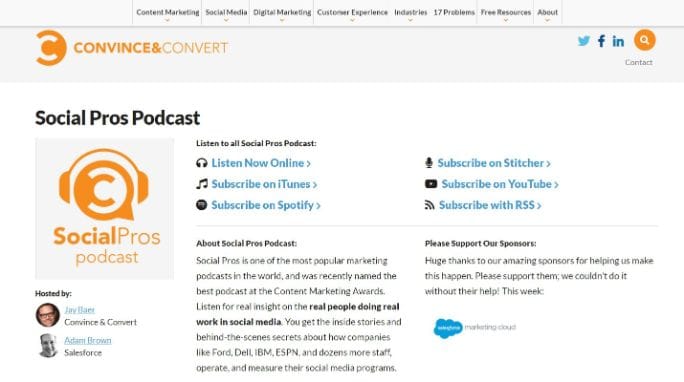
3. GaryVee Audio Experience with Gary Vaynerchuk
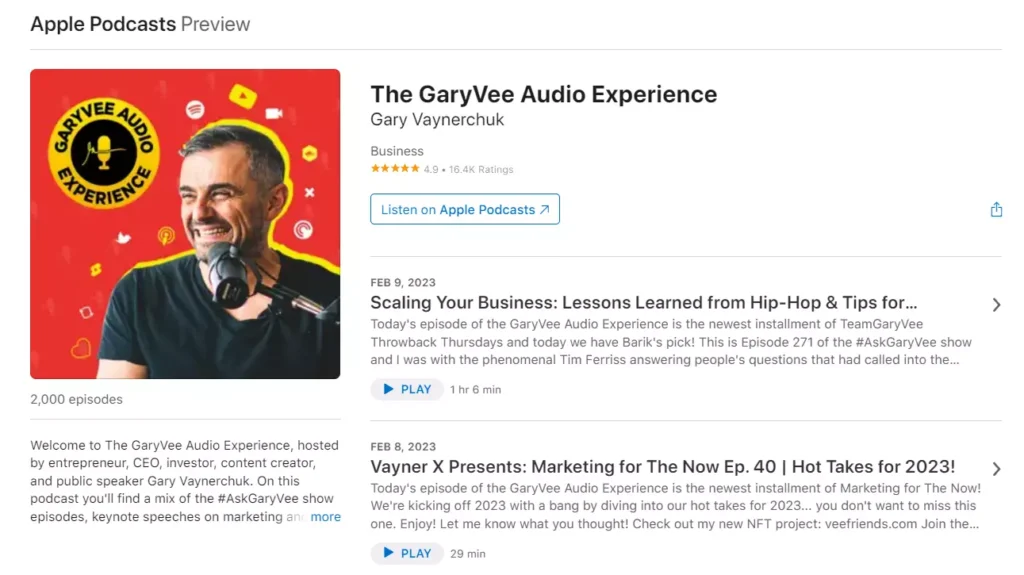
The GaryVee Audio Experience is hosted by the renowned American entrepreneur, speaker, and author. With a substantial following, the podcast compiles segments from various sources, including the #AskGaryVee show, Gary’s DAILYVEE series, interviews, and exclusive recordings produced specifically for this show.
Having been a mainstay for quite some time, the GaryVee Audio Experience boasts an extensive catalog of over 2400 episodes, with new content added almost daily. The series has gained widespread popularity for Gary’s insightful speeches on marketing, engaging interviews, and valuable business insights.
Accessible on eleven different platforms, including Spotify, SoundCloud, and Apple Podcasts, this podcast provides listeners with diverse content, making it a go-to resource for those interested in marketing, entrepreneurship, and business success. Tune in to stay updated on GaryVee’s latest thoughts and experiences in the dynamic world of business and marketing.
4. The Art of Online Business with Rick Mulready
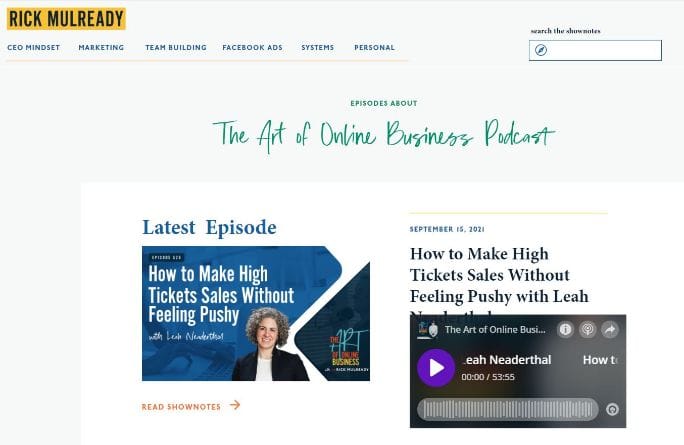
With social media feeds getting busy with the constant stream of sponsored and brand-specific content, engagement has moved to the closed corners of the platfrom.
Another reason for this shift is that people feel more at ease sharing their opinions within specific groups rather than putting them out there for everyone to see.
We’ve all seen how political and topical discussions in open spaces can turn into fiery arguments, causing more trouble than they’re worth.
On Instagram, more and more people are connecting with others through closed stories or DMs.
Adam Mosseri, the head of Instagram, also agreed that people on Instagram now post many more stories and send many more DMs than they post to their main feed.
Embracing Private Conversations: The Evolution of Social Media Engagement
Recognizing the growing preference for private conversations, Instagram has introduced several direct messaging (DM)-centered features, including Notes and Broadcast channels. In a similar vein, TikTok enables users to receive messages from anyone on the platform of their choosing.
This shift toward direct messaging not only caters to the audience’s love for more personal interactions but also solidifies social media’s role as a pivotal customer service channel.
The integration of chatbots, instant messaging, and AI-powered customer support has ushered in a transformative era in how consumers engage with brands. This evolution in communication channels not only facilitates seamless interaction but also underscores the importance of providing personalized and efficient customer service in the dynamic landscape of social media
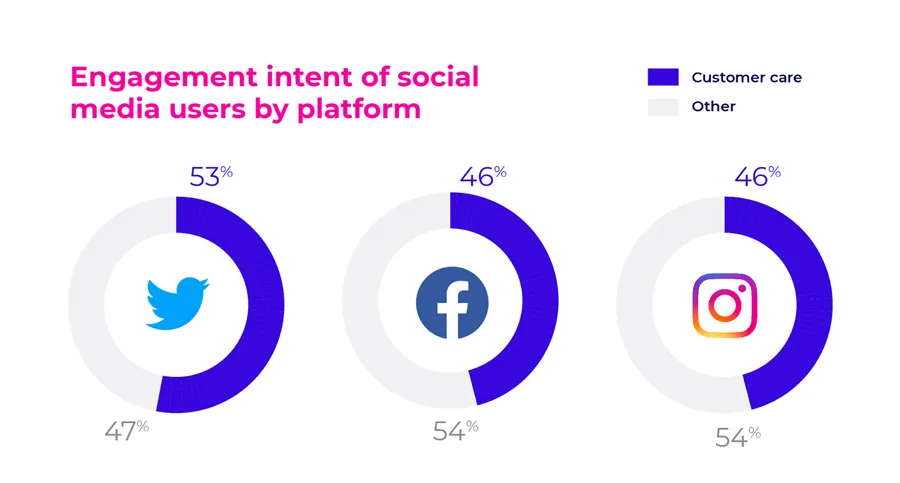
Seizing the Momentum: Strategies to Leverage Real-Time Social Media Engagement
The ability of businesses to offer real-time responses to customer inquiries and concerns has transformed these interactions into valuable opportunities for building trust, loyalty, and satisfaction. The chat window on social media now acts as an immediate bridge between brands and consumers, facilitating instant connection.
Key Actions to Harness This Trend:
Encourage Direct Communication: Foster direct communication by encouraging your audience to connect with questions and feedback through DMs. Creating an open channel for dialogue enhances the personal connection between your brand and customers.
Utilize Social Inbox Tools: Equip your social media team with social inbox tools like SocialPilot to efficiently manage and promptly respond to DMs across platforms. Streamlining communication channels enhances your team’s ability to provide real-time responses.
Implement Automated Responses: Set up automated responses to swiftly reply to frequently asked questions. This not only saves time but ensures that your audience receives immediate acknowledgment, contributing to a positive user experience.
Cultivate Community Relationships: Focus on transforming your social media following into a genuine community. Foster personal connections through DMs, groups, or channels. This approach cultivates more meaningful engagement and builds stronger relationships with your audience.
Collaborate with Influential Creators: Build relationships with influential creators who already have an established community on social channels. Partnering with these creators can extend your brand’s reach and tap into existing communities, enhancing your real-time engagement efforts.
Trend #6: Redefining Sustainability Communication
Embracing Sustainability: The Imperative for Modern Brands
Sustainability has evolved from a mere choice to an absolute necessity for contemporary brands. In an era where environmental consciousness takes precedence, brands adopting sustainable practices resonate profoundly with an expanding eco-conscious consumer base.
A staggering 84% of customers assert that they would distance themselves from a brand or company with poor environmental practices. This underscores the critical role of sustainability in shaping consumer perceptions and choices.
Social media emerges as a pivotal platform for these eco-friendly brands to share their sustainability initiatives, promote eco-conscious products, and highlight corporate responsibility efforts. However, a crucial caveat exists – authenticity and transparency in these communications are paramount.
Brands that effectively convey their sustainable practices and commitment to minimizing environmental impact create a robust connection with their audience. The alignment of brand values with those of eco-conscious consumers transcends a mere positive environmental impact; it becomes a foundation for building a loyal customer base.
An exemplary case in point is Patagonia, an American retailer of outdoor recreation clothing. Through its social media channels, Patagonia consistently showcases its unwavering commitment to environmental causes and sustainable practices. This transparent communication not only reinforces the brand’s values but also establishes a profound resonance with its audience.

To harness the sustainability trend:
Know Your Audience: Understand your audience’s eco-consciousness, preferences, and values.
Craft a Strategic Approach: Develop a focused social media strategy highlighting sustainability initiatives and eco-friendly products.
Share Authentic Stories: Communicate genuine stories about your sustainability journey and real-life impact reduction.
Encourage Participation: Drive engagement with eco-friendly challenges and discussions, fostering a sense of community.
Explore Partnerships: Consider collaborations with environmental organizations or influencers aligned with your sustainability values.
Trend #7: Social Media are Becoming Search Engines
Shifting Landscapes: Social Media as the New Information Hub
In a transformative shift, social media has become more than just a platform for connecting; it’s now a vital source for discovering news, products, and insights, challenging the dominance of traditional search engines.
According to Senior Vice President Prabhakar Raghavan of Google’s Knowledge & Information organization, nearly 40% of young people now turn to platforms like TikTok or Instagram instead of Google Maps or Search when seeking recommendations, like where to have lunch.
What’s driving this change? It boils down to convenience and relevance. Trust in recommendations and insights from real faces now outweighs faith in faceless websites, marking a significant evolution in how people seek and trust information.
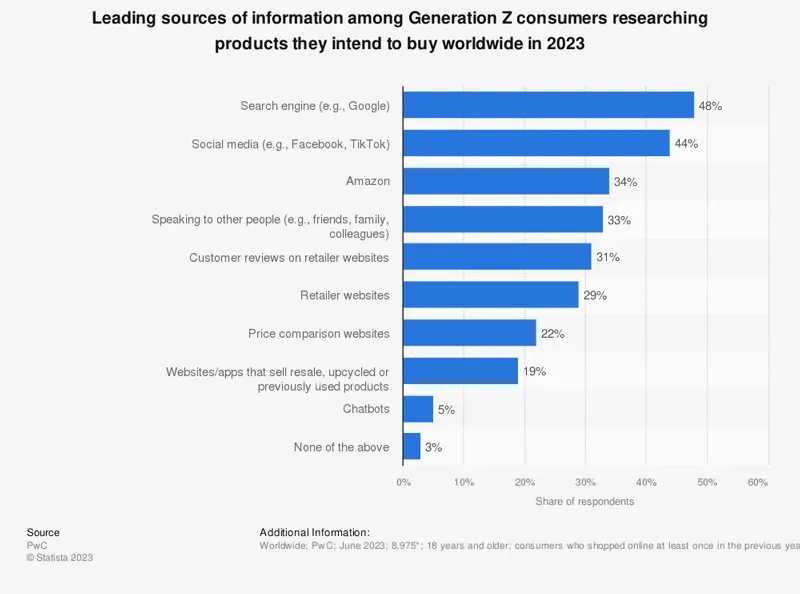
Evolution in Search Dynamics: Social Media Platforms Enhance Exploration
Meeting the audience’s exploration demands, social media platforms are enhancing their search experiences. TikTok, for example, now displays Google search results within its in-app results. Additionally, most social media platforms, TikTok included, have introduced functionalities allowing ads to be part of user search results.
However, it’s crucial not to abandon Google search efforts altogether. Despite the increasing reliance on social media for initial exploration, Gen Zers still turn to search engines to evaluate products or brands after their initial social media exploration. The synergy between social media exploration and subsequent detailed evaluations on search engines highlights the evolving role of both platforms in the consumer journey.
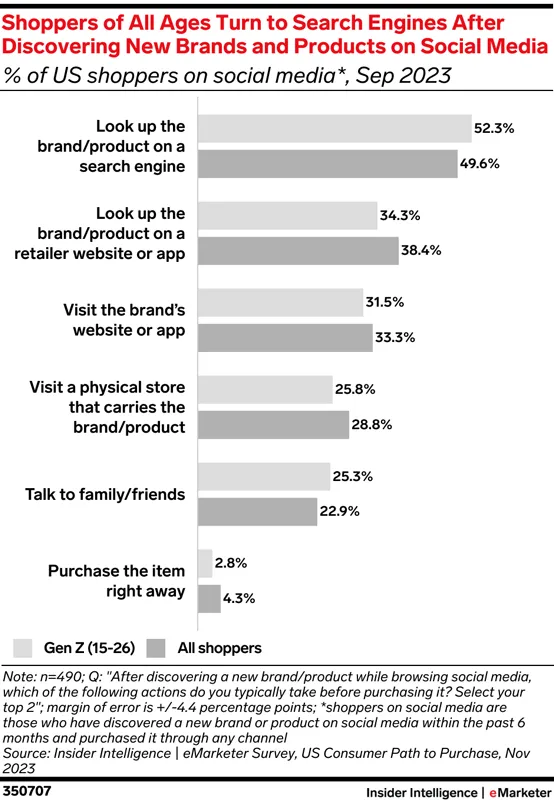
Trend #9: Championing Employee Advocacy
Leveraging Employee Advocacy: A Powerful Social Media Marketing Tool
Employee advocacy has emerged as a potent tool in the social media marketing arsenal, and here’s why:
Humanizing the Brand: When employees share their experiences and insights, they humanize the brand, establishing trust and authenticity in an era where genuine connections are highly valued.
Higher Engagement Rates: Employees’ personal networks often boast higher engagement rates than official brand channels, providing a unique avenue for reaching and resonating with a broader audience.
Authentic Perspectives: Employees can offer an authentic perspective by sharing aspects of company culture, achievements, and behind-the-scenes glimpses, fostering a deeper connection with consumers.
Cultural Integration: Employee advocacy goes beyond content sharing; it involves creating a culture where employees feel valued and connected to the brand’s mission. This sense of belonging leads to more passionate and effective advocacy, enhancing the brand’s reputation.
Strategies to Harness this Trend:
Identify Brand Ambassadors: Identify enthusiastic and engaged employees willing to become brand ambassadors.
Provide Training Sessions: Offer training sessions or resources to educate employees about effective social media practices and the guidelines they need to follow.
Facilitate Content Sharing: Make it easy for employees to share brand content by providing shareable assets like images, articles, videos, and relevant hashtags.
Recognition and Incentives: Offer shoutouts, incentives, or gamification to motivate and appreciate employees’ advocacy efforts.
Trend #11: Decentralized Platforms Will Gain More Traction
Embracing Decentralized Social Media: Strategies to Navigate the Trend
As decentralized social media platforms gain traction, consider these strategies to harness the trend:
Explore Decentralized Platforms: Create accounts and explore the functionality of decentralized platforms to gain firsthand experience and understanding of their operations.
Analyze Target Audience Presence: Assess whether your target audiences are already present on decentralized platforms or show interest in exploring them. Understanding audience preferences is key to effective engagement.
Stay Informed on Developments: Keep a close eye on developments in the decentralized space, including platform growth, emerging competitors, and regulatory changes. Being informed positions you to adapt your strategy accordingly.
Educate Stakeholders: Educate your stakeholders about the benefits and challenges of decentralized platforms. Help them make informed decisions about expanding their presence in this evolving space.
Trend #12: The Rise of Social Commerce
Revolutionizing E-Commerce: The Ascendancy of Social Commerce
The integration of online shopping and social media, known as social commerce, is reshaping the landscape of internet shopping. According to Statista, global social media sales are anticipated to reach $1.3 billion in 2023, with projections indicating a potential surge to nearly $3 trillion by 2026.
This convergence of social interaction and e-commerce is not just a trend but a paradigm shift, underscoring the significant impact of social commerce on the future of online retail.
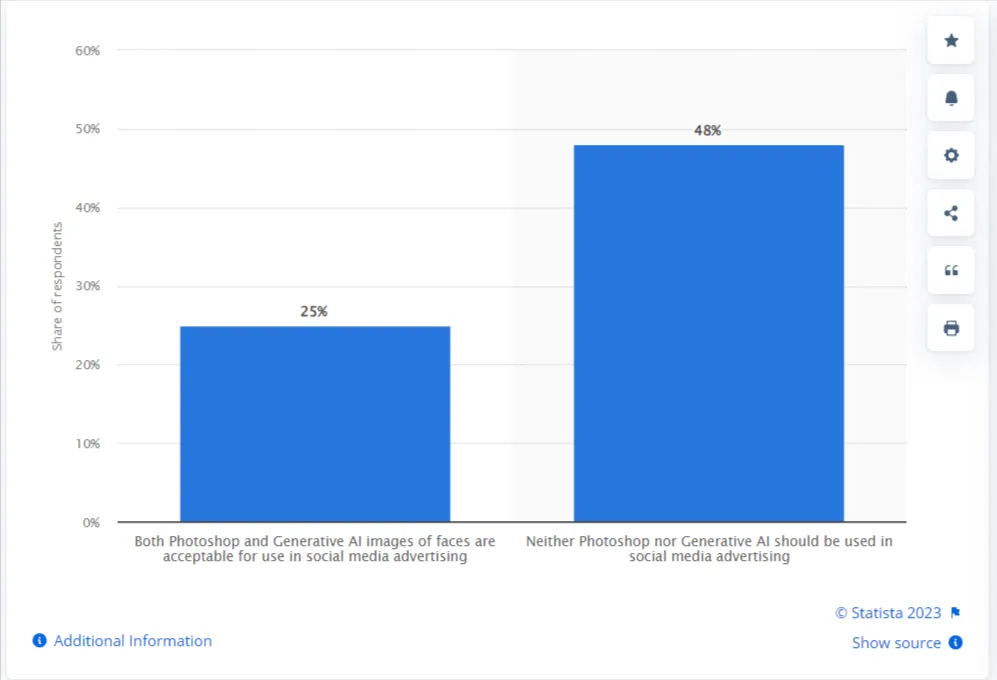
Seizing the Social Commerce Wave: Strategies to Leverage the Growth
The significant growth in social commerce is fueled by the integration of in-app shopping experiences, transforming social media platforms into vibrant marketplaces. Platforms like TikTok, Instagram, and Facebook lead the way with features such as live shopping, shoppable videos, and product showcases.
To harness this trend effectively:
Choose the Right Platform: Assess which platform—TikTok, Facebook, or Instagram—best suits your brand. Focus on channels where their audience actively engages with product posts for more effective conversions.
Create Immersive Shopping Experiences: Focus on crafting engaging and immersive shopping experiences within the social media ecosystem. Incorporate elements like shoppable videos, live shopping events, and interactive content to captivate your audience.
Collaborate with Influencers: Collaborate with influencers who align with your brand and can effectively promote products within their niche communities. Influencers play a crucial role in driving awareness and engagement.
Adopt Shoppable Ads: Start incorporating Shoppable ads into your strategy to facilitate direct and streamlined purchasing experiences for your audience.